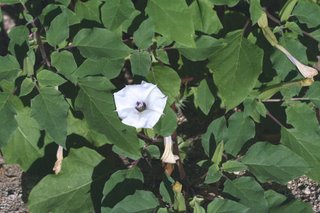
I originally posted this plant as Datura wrightii. However, as you'll see from the comments, ontario wanderer and michele corrected me. [Check out their blogs - they're both awesome!] Datura wrightii has all white flowers and is a perennial with a large underground tuber. Datura stramonium is either purple or has purple centers and is an annual. Thanks ow and michele!
Jimson Weed or Sacred Thorn-apple (Datura stramonium) is highly poisonous. Therefore, beautiful as it is, I don't want these plants growing in my patio or the play yard where my young grandchildren would be able to get at them. According to Firefly Forest's Wildflowers of Tucson, Arizona web site, all parts of the Jimson Weed plants are poisonous. They are hallucogenic and ingestion can be fatal. The poisons are Tropane alkaloids including hyoscyamine (an isomer of atropine) and scopolamine (hyoscine).


4 comments:
We have Datura stramonium here in Ontario. Nice flower and, yes, poisonous. I have seen other Daturas in the Grand Canyon and in Kenya. They all have that large trumpet-like flower and are all beautiful.
ow - I looked up Datura stramonium. It looks very similar. It's also known as Jimson Weed. Maybe all daturas are? As I look them up, I find it difficult to tell the difference from photos.
Datura wrightii has all-white flowers, while D. stramonium has the purple spots. D. stramonium tends to be an annual while D. wrightii is a perennial with a large underground tuber. Also I think the flowers are somewhat larger.
In South America the shamans are using it for healing, however they know how to use it if connect with the plant in a spiritual way. I took it in ceremony n it helped with my health.
I would never suggest someone to ingest it unless they know what they are doing.
Post a Comment